Table of Contents
Introduction to Sportfishing Flag Etiquette
Nothing shouts “careless crew” louder than a bunch of release flags crammed together at the top of an outrigger, all uneven and messy. The way you display your flags says a lot more than just the number of fish you’ve caught—it’s a big deal in the world of professional fishing. While most of what’s written about release flags dives into their history, you’ll hardly find anything on the dos and don’ts of flag flying. Trying to pin down rules on how high to hoist your flags or how far apart they should be? Good luck. It’s really up to you how you want to show off your flags, but if you chat with any seasoned mate or captain, you’ll find out they all have their own special method to make them look just right. In the fishing world, there’s a silent agreement on flag etiquette—what’s cool and what’s not.
The Importance of Flag Symmetry
Captain Scott Adams with Viking Yachts shares his expertise on sportfishing flag etiquette and properly displaying sportfishing flags with precision. He emphasizes the importance of keeping flags evenly spaced for a polished look. “You wouldn’t want your flags scattered – one 3 feet away, the next 2 feet, and another just 6 inches. It appears messy and might turn you into a laughing stock at the dock,” he says. For single releases, like a marlin flag, it shouldn’t be too high; it should be easy for someone strolling by to see without straining their neck. Adams prefers to position a small number of flags at or just above eye level to catch attention easily. When handling several flags, he uses a creative method to ensure even spacing by using a flag’s length as a guide, ensuring each flag is spaced perfectly from the next. This approach helps maintain a consistent and tidy appearance, no matter how many flags you’re displaying. Additionally, the length of your outrigger plays a role in flag spacing, but a solid tip is to align them between the bridge deck and the outrigger’s last spreader for optimal visibility and aesthetics.
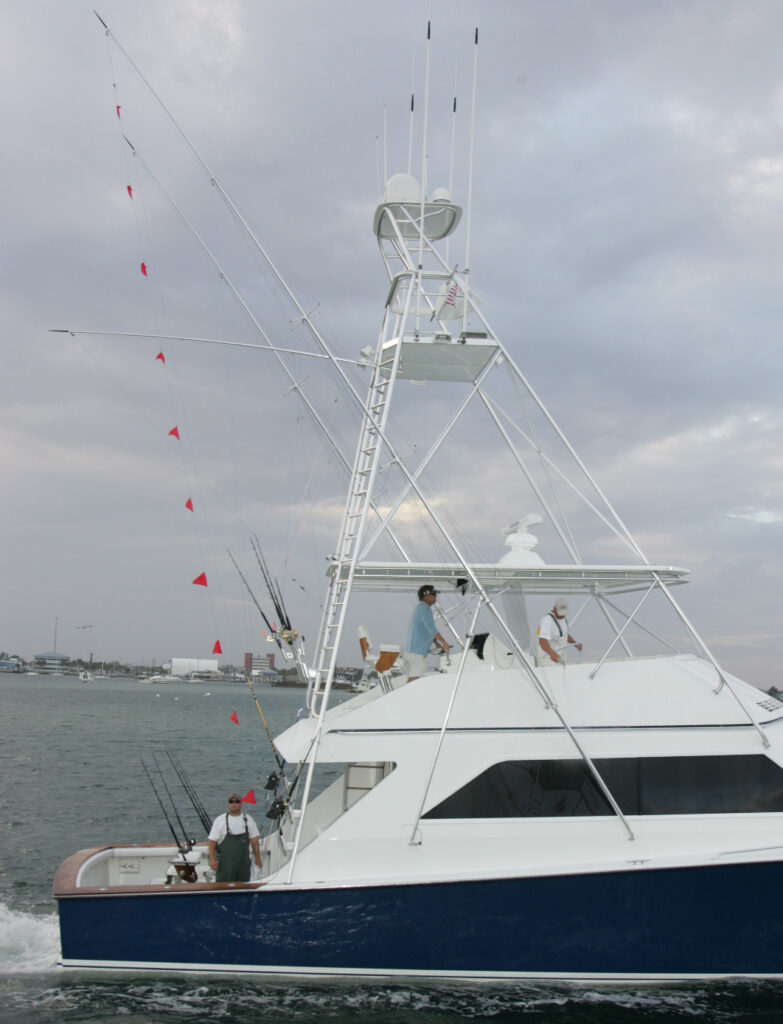

Traditional and Modern Approaches to Flying Flags
Captain John Duffie of Duffie Boatworks and captain of the Billfisher is particular with sportfishing flag etiquette and how he flies his flags. He has a specific system, much like Captain Adams, to ensure all his flags are evenly spaced. “Seeing flags all bunched up or too high on the outrigger really bothers me,” Duffy says. He’s quick to correct his crew if a flag isn’t positioned correctly. Unlike some, Duffy prefers using full-sized release flags instead of smaller ones. For him, the number of fish caught dictates the spacing: four release equal a flag for each arm’s length apart, six to eight catches require a bit less space, and for twelve or more, the length or width of the flag determines the spacing.
Captain Ryan Higgins, with Valhalla Boatworks, shares a common annoyance: inconsistent flag types on the same rigger. “Mixing different sized flags looks untidy. It’s best to stick with one type,” Higgins advises. This uniform approach to flag flying not only keeps things looking neat but also follows an unwritten standard among the pros.
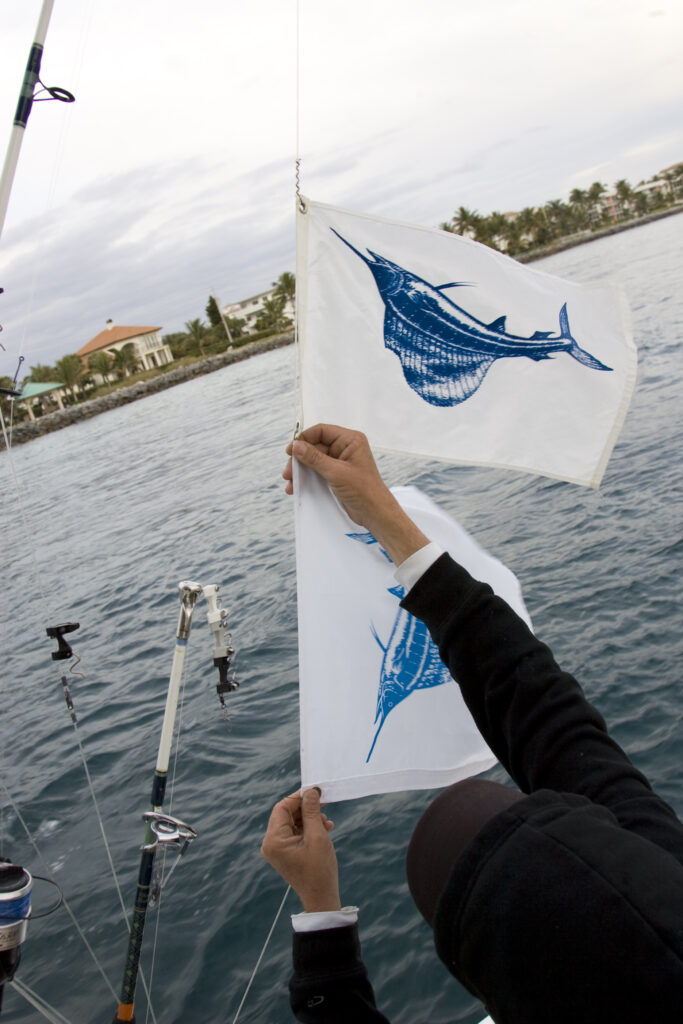
Captain Scott Fawcett, from Stuart, Florida, who runs Off the Chain Sportfishing Charters, sticks to tradition with his sailfish flags, favoring the classic red pennants. Like many seasoned captains, Fawcett is fond of sportfishing flag etiquette has precise standards for how his flags should be displayed. “Ideally, I’d like all the flags close together on the outrigger, but it’s more important that they’re visible and catch the eye,” he explains. For a smaller number of flags, Fawcett spaces them out starting from two-thirds to three-quarters up the outrigger, using one arm’s length between each for uniformity. If more flags are needed, he uses a unique method: attaching the first flag, then determining the position of the next by bending his arm and using his elbow as a guide. This technique ensures the flags look evenly spaced and symmetrical. Fawcett also notes that if an outrigger can’t accommodate all flags, they should be shifted to the opposite side rather than crowding them. He emphasizes the importance of current display practices, suggesting that charter boats should only showcase flags from their latest outing, maintaining a tidy and up-to-date appearance- not a false sense of fishing activity.
The Evolution of Sportfishing Flags
It’s pretty clear why many pro crews feel proud of their flag displays. After all, these flags are a top honor for their fishing achievements. Some folks think flags might not be necessary, but every captain we talked to believes if you do fly them its a good practice to taking down all your fishing flags by noon the next day. If you missed taking them down in the past by noon, you could almost bet a dock buddy would have fun pinning one of your flags to the dock as a playful reminder of tradition. Whether a flag flies right side up or upside down is a discussion for another day. The main point? If you’ve earned those flags, proudly show them off, but remember to keep things neat and organized. That’s the professional way!
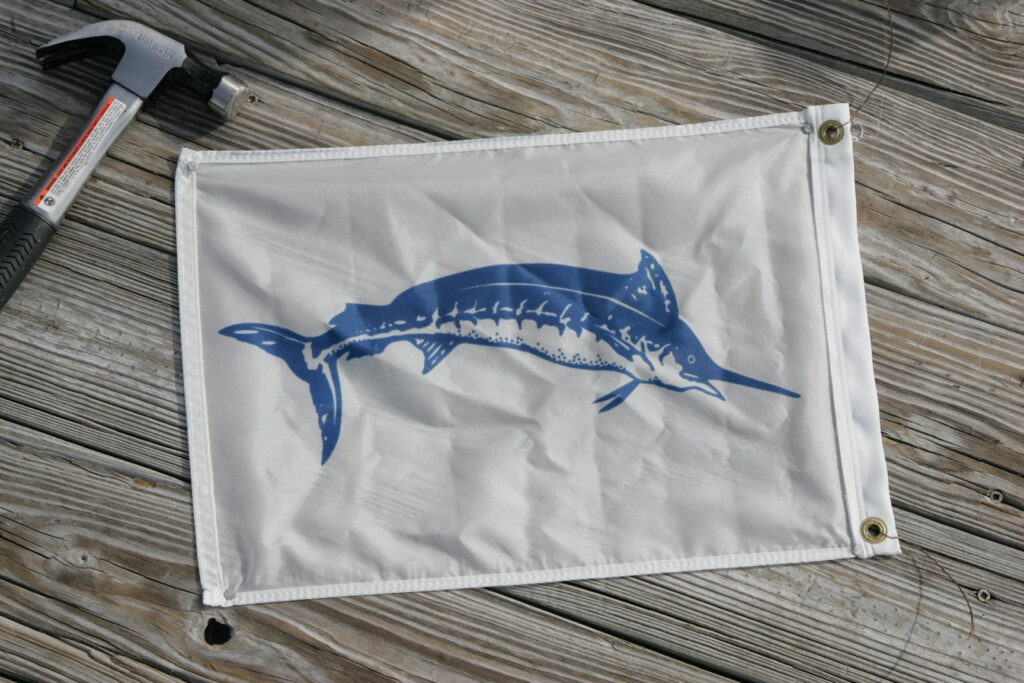
Sportfishing Flags: A Tradition Since 1939
Since 1939, sportfishing boats out of Palm Beach, Florida, have been showcasing their catches with flags. The introduction of the red release pennant was a game-changer in the sportfishing world. Before these flags, the catch and release of sailfish often went unnoticed. Fishermen, eager for acknowledgment and boasting rights, would bring their catch onto the boat for all to see, which also proved beneficial for charter captains looking to demonstrate their prowess and attract more business.
In an effort to promote conservation, members of the West Palm Beach Fishing Club initiated the use of red pennants at the 1939 Silver Sailfish Derby Tournament, a tradition that persists today. Over time, sportfishing flags have grown to represent a variety of pelagic species, with billfish flags being the most common. The choice to use the starboard rigger for flags likely stems from early standard practices adopted by pioneer crews. Regional practices influence flag styles, too. For instance, Hawaiian crews might display a white marlin flag above a red pennant to indicate a tagged fish. In the Gulf of Mexico, it’s typical to see an array of flags for tuna, wahoo, and dolphin, alongside billfish flags after a long trip. Meanwhile, New Zealand crews are known for their distinctive black and white swordfish flags flown with billfish flags, showcasing the rich diversity and heritage of sportfishing culture around the globe.
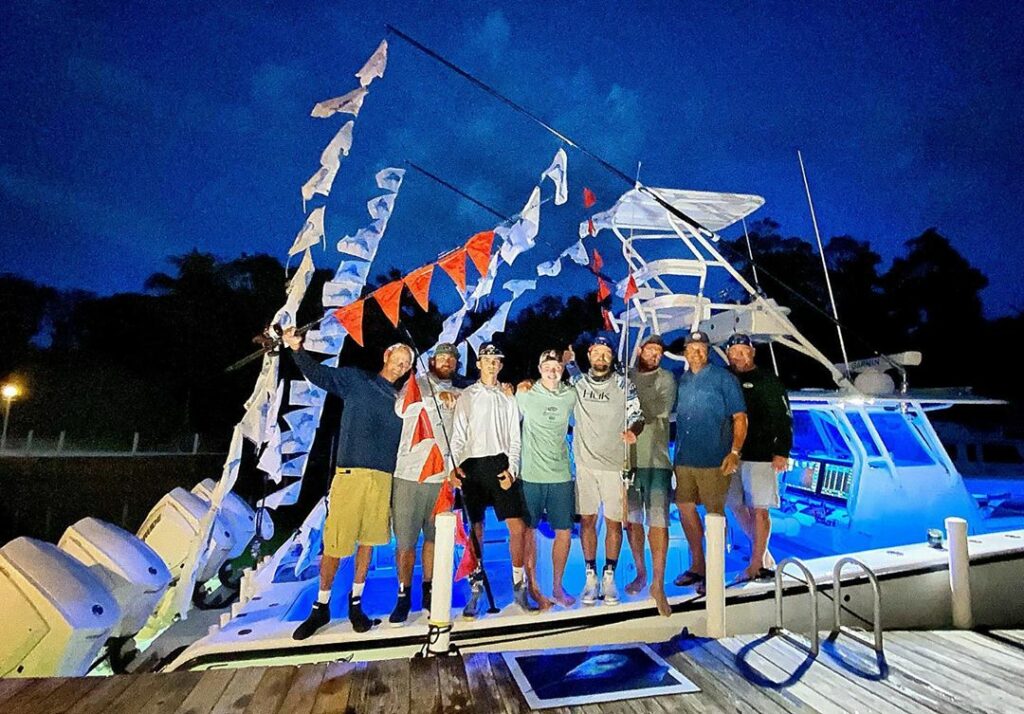
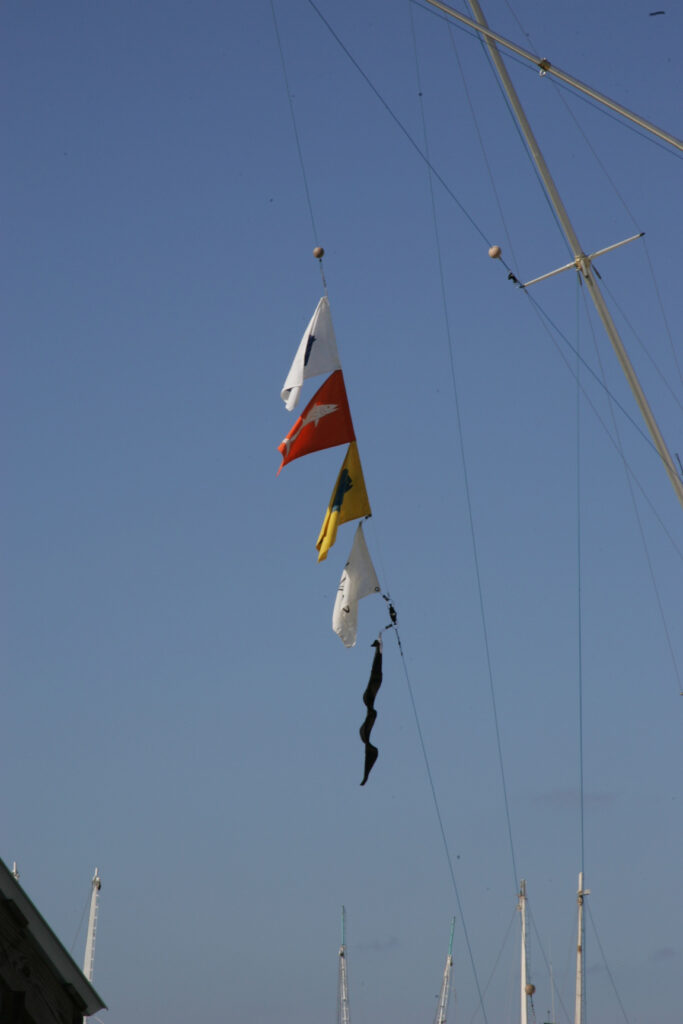
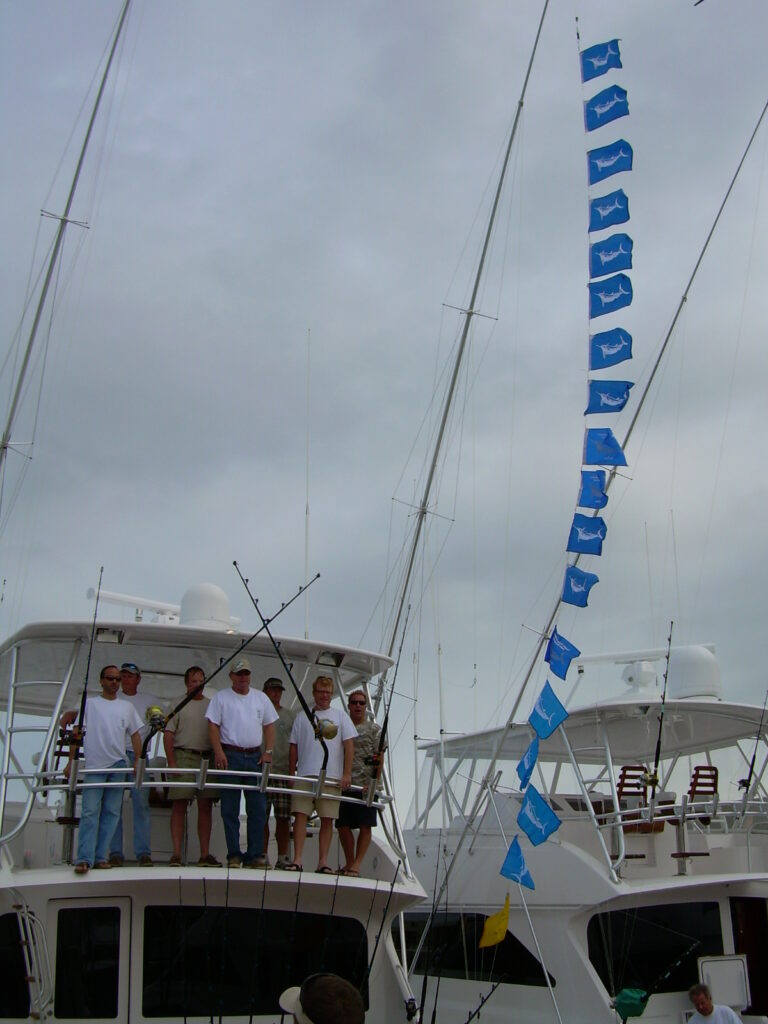

Don’t Forget to Check Out Our Sportfishing Job Board! Did You Know? It’s the perfect platform for seeking skilled captains and mates. Whether you’re on the hunt for your dream team or looking to join one, your next big adventure begins here. Explore the opportunities now! Click Here
Dive Deeper into the World of Sportfishing
Unlock Exclusive Savings: Enjoy 50% Off Your Subscription!
Are you ready to explore the thrilling world of sportfishing from the comfort of your home? Subscribe now and embark on a journey filled with captivating stories, expert insights, and insider tips. Choose between our digital or print edition and secure an incredible 50% discount on your subscription.
Subscribe today and get ready for an adventure like no other. Click here to subscribe and elevate your sportfishing experience with InTheBite Sportfishing Magazine.















